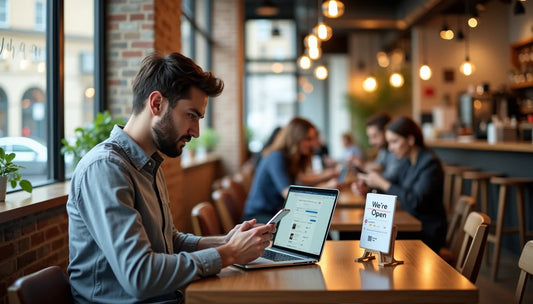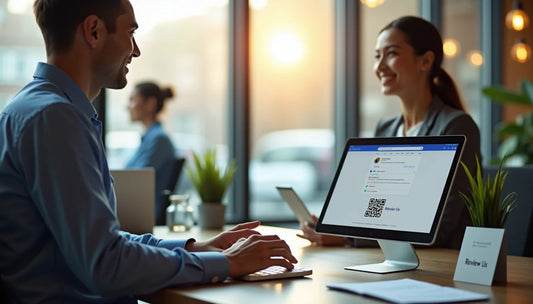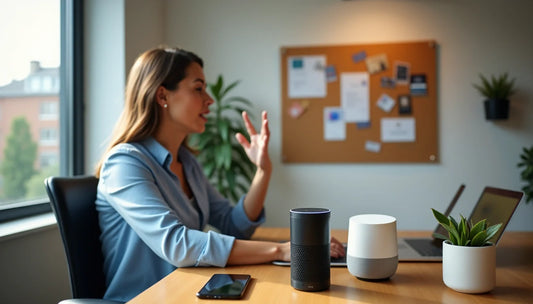Mobile devices and smartphones now account for over 60% of Google searches .
The numbers tell an even more compelling story. When people search for local businesses on mobile, 88% either call or visit within 24 hours . Mobile local SEO has become critical for businesses of all sizes. "Near me" searches have surged by 900% , making mobile optimization essential for business success.
Google recommends pages should load in under three seconds on mobile devices . Many local businesses still face challenges with mobile optimization. Local business searches happen at least once a week for 8 out of 10 consumers . This makes local SEO optimization a consistent chance to attract new customers.
In this piece, we'll explore mobile optimization tips that boost your local SEO strategies. The content helps businesses that are starting out or want to improve their current approach. These practical steps can significantly improve your search visibility.
Why Mobile Optimization Matters for Local SEO
Image Source: Takteek
Mobile optimization is now the backbone of successful local SEO. Most website traffic comes from mobile devices. Your business misses valuable opportunities by skipping this vital aspect.
The rise of mobile-first indexing
Mobile-first indexing brings a fundamental change in how search engines rate websites. Google uses your site's mobile version for indexing and ranking instead of the desktop version [1]. This change mirrors how users browse the web, as smartphones and tablets generate most web traffic [2].
Google made it clear that websites without mobile optimization face big disadvantages since rolling out mobile-first indexing. The search engine looks at your mobile content first to determine rankings for both mobile and desktop searches [1]. Your content won't get indexed if it exists only on the desktop version [1].
How mobile behavior influences local search
Mobile devices have changed local search patterns. These numbers tell the story:
-
76% of people visit a related business within 24 hours after searching on their smartphone [3]
-
28% of these visits lead to a purchase [3]
-
"Near me" searches grew by 500% over the last several years [4]
-
Local searches show high buying intent - 18% of local smartphone searches result in purchases within a day [3]
Mobile users want quick results when searching locally. They look for basic details like hours, directions, or contact info and want it right away [5]. Searches with phrases like "open now near me" jumped 400%, showing that people just need immediate service information [6].
Impact on visibility and rankings
A mobile-ready website boosts your local SEO performance in many ways. Businesses with mobile-friendly sites get 50% more engagement than those without proper setup [6]. Slow mobile sites hurt your visibility because 53% of mobile visitors leave if pages take over three seconds to load [7].
Google's local search system rewards websites that work well on mobile and show local relevance [7]. Your rankings will drop if your site isn't responsive or loads slowly, even with other SEO work in place [7]. Mobile optimization affects both rankings and key metrics like bounce rates and time on site [5].
Local businesses face tough competition without proper mobile optimization. Companies with mobile-friendly sites will rank higher in local search results [1]. This visibility gap costs opportunities since 60% of smartphone users pick businesses from the top three results [6].
Making mobile optimization a priority in your local SEO plan helps you reach more customers who use phones to find local solutions quickly.
Core Mobile SEO Optimization Techniques
Mobile SEO implementation needs technical expertise and careful planning. Here are the optimization techniques that will boost your local business rankings in mobile search results.
Use responsive design for all devices
Responsive design is the life-blood of mobile optimization and Google's recommended approach for local businesses. Responsive design serves the same HTML code on a single URL whatever device type you use, and it adjusts the layout automatically to fit different screen sizes [8]. Your local SEO efforts benefit from this approach in several ways:
Responsive design eliminates duplicate content problems and helps you avoid SEO issues that come with separate mobile and desktop versions. Googlebot needs to index your content only once, which saves resources during site crawling [9].
Your responsive design implementation should:
-
Use a flexible framework like Bootstrap with percentage-based layouts instead of fixed pixel dimensions
-
Add CSS media queries to adjust styling based on screen sizes
-
Check your site on multiple devices to confirm proper rendering [8]
Improve mobile page speed
Page speed is vital for mobile users because of hardware and connectivity limitations [10]. Google's ambitious guideline recommends your mobile pages load in under one second [2]. Studies show that a one-second delay can drop conversions by up to 20% [8].
These steps optimize your mobile page speed:
-
Compress images without quality loss using tools like TinyPNG [4]
-
Minify CSS, JavaScript, and HTML to reduce file sizes [1]
-
Enable browser caching to store commonly used resources [11]
-
Load above-the-fold content first so users see something right away [4]
Google's PageSpeed Insights tool can review your current mobile speed by checking Core Web Vitals metrics like Largest Contentful Paint (LCP) and Cumulative Layout Shift (CLS) [9].
Simplify mobile navigation
Desktop navigation often fails on mobile devices. Touch-friendly navigation matters since 94% of mobile users view content vertically [1].
Your mobile navigation should:
-
Include buttons and interactive elements of at least 48 pixels [1]
-
Keep navigation elements 32 pixels apart to prevent wrong taps [1]
-
Use a hamburger menu to save valuable screen space [4]
-
Place key navigation options within thumb reach [12]
A confusing navigation structure increases bounce rates. Clear navigation keeps users engaged and improves SEO performance [4].
Ensure readable content on small screens
Mobile users scan content differently than desktop users. They often leave sites that need pinching or horizontal scrolling to read text [2]. These tips improve readability:
-
Set body text font sizes to 14-16px minimum [8]
-
Keep paragraphs brief (2-3 lines maximum) for easy scanning [9]
-
Create strong text-background contrast for better visibility in different lighting [12]
-
Add headings, bullet points and white space to break up content [1]
-
Use shorter headlines and meta descriptions (under 60 characters for titles and 105 for descriptions) [1]
Mobile users spend less than 3 minutes on a site typically. This makes it important to put key information first [1]. Organizing content in digestible chunks improves user engagement and helps your local search rankings.
Local SEO Features to Prioritize on Mobile
Image Source: Boom Online Marketing
After you optimize your mobile site structure, the next step focuses on local SEO features that deliver immediate results. Your mobile local SEO success depends on elements that work best for users who are always moving.
Add click-to-call and map buttons
Mobile users need simple ways to reach businesses. Studies show that up to 70% of mobile users tap click-to-call buttons [13]. Consumers spend about $1.12 trillion through click-to-call tools each year [13]. These buttons make the customer's experience smooth and let potential clients reach you right away.
Local businesses see a 121% boost in participation when they add tappable "Call Now" or "Get Directions" buttons [14]. Well-laid-out call-to-action buttons make clicks 30% more likely and improve conversions by 20% [14]. These elements should stand out on your mobile pages.
Use local keywords and 'near me' phrases
Location-based searches have exploded, creating a huge chance for businesses. "Near me" searches have grown by over 500% recently [15]. About 82% of smartphone users look for businesses close to them [3].
The best way to attract this traffic is to use location-specific keywords in your content. Skip generic terms. Instead, use phrases like "emergency electrician in Edmonton" to target specific areas [6]. Search engines will better understand your business location and show you more often in local results.
Optimize your Google Business Profile
Your Google Business Profile (GBP) is the life-blood of mobile local SEO. A complete profile brings 70% more local visits [1] and improves your visibility on Google Maps and local search results.
The profile works best when you verify your business, keep hours current, and fill out every section [16]. Good photos matter - businesses that use them get more website clicks and directions requests [17]. The business categories you pick also shape how often you show up in local searches [18].
Ensure NAP consistency across directories
Name, Address, and Phone number (NAP) consistency builds trust with users and search engines alike. Wrong information can hurt your site's performance by 16% [14]. About 63% of customers won't contact businesses that show incorrect details [14].
Your NAP information should match across online platforms - your website, Google Business Profile, and directory listings [19]. Regular checks help find and fix differences that could hurt your mobile local SEO. Tools like BrightLocal or Moz Local make this process easier [20].
Avoiding Common Mobile SEO Mistakes
Image Source: TheeDigital
Mobile SEO success depends on both optimization techniques and staying clear of common mistakes that can hurt local businesses.
Slow loading times
Load speed plays a crucial role in mobile SEO results. Mobile pages load 87.84% longer compared to desktop versions [7]. This creates a tough challenge for users. Pages that take more than three seconds to load see their bounce rates shoot up [7]. This can undo all your SEO work.
Speed problems can be fixed by:
-
Using TinyPNG to compress images
-
Setting up browser caching for static resources
-
Getting better hosting service
-
Adding a Content Delivery Network (CDN) to serve content worldwide [7]
Unoptimized images
Large images slow down mobile sites more than anything else [21]. All the same, users prefer sharp, clear photos over low-quality ones [21].
The right way to optimize images:
-
Match image size to screen needs (640 by 320 pixels works best) [22]
-
Pick modern formats like WebP that create files 25% smaller than PNG and JPG [22]
-
Add lazy loading so images appear only as users scroll to them [7]
Poor mobile navigation
Bad navigation makes users leave quickly and hurts local SEO rankings. Small buttons, crowded menus, and clustered links don't work very well with mobile users [7].
Better navigation comes from:
-
Making buttons 48 pixels or larger so they're easy to tap
-
Adding sticky navigation bars that stay visible while scrolling
-
Creating clear visual guides with familiar icons and distinct colors [7]
Missing structured data
Structured data tells search engines exactly what your content means. This leads to rich results that users love to click. Sites with structured data see 25% more clicks [5], which helps mobile SEO substantially.
Structured data works best when you:
-
Add all needed properties for better search displays
-
Make sure everything is accurate instead of adding too much
-
Check your work with Google's Rich Results Test
-
Keep data current as your site changes [23]
Tracking Results and Improving Conversions
Image Source: AgencyAnalytics
Proper tracking serves as the foundation of any successful mobile local SEO campaign. You cannot determine if your optimization efforts deliver results without measuring them correctly.
Use Google Analytics for mobile behavior
Google Analytics explains how mobile users interact with your site. Custom goals help track specific conversions from local traffic. The key focus areas include:
-
Mobile traffic segmentation
-
Geographic reporting to determine visitor origins
-
Analysis of user paths across mobile pages
Configuring Google Analytics correctly shows which mobile optimization strategies create business results beyond rankings [24]. Separate mobile traffic analysis helps you learn about device-specific patterns [25].
Monitor bounce rate and time on site
The bounce rate shows the percentage of visitors who leave after viewing just one page - the opposite of participation rate [26]. High bounce rates signal content irrelevance or poor user experience [27]. Time on site measures your content's ability to hold visitor attention.
These metrics affect your rankings in mobile local SEO. Pages that keep users longer line up better with visitor needs [24]. Compare these metrics against site averages to spot underperforming pages [28].
Track mobile conversions like calls and visits
Rankings and traffic don't pay bills—new customers do [29]. Call tracking with unique phone numbers for different marketing sources [2] captures valuable data about call duration, location, and marketing attribution [2].
Your Google Business Profile needs a local call tracking number as the primary contact with your real number as backup [29]. UTM tracking codes help measure website visits from your business profile accurately [29].
Conclusion
Mobile local SEO gives businesses a great chance to grow when they invest in proper optimization. This piece explores key strategies that can substantially affect your local visibility and how customers interact with your business.
Search engines have completely changed how they look at websites with mobile-first indexing. Mobile optimization isn't optional anymore - it's crucial. Your business might become invisible to smartphone users if you don't adapt quickly.
Responsive design forms the foundation of effective mobile SEO. Fast page speeds and user-friendly navigation create the technical framework you need to succeed in search. The content must be easy to read on smaller screens so visitors stay engaged instead of returning to search results.
Technical optimization is just the start. Local-specific features like click-to-call buttons, "near me" keyword targeting, and an optimized Google Business Profile help mobile users find and reach your business easily. Your NAP consistency builds local authority in the digital world.
Google Analytics data, bounce rates, time on site metrics, and conversion tracking give you useful information about what works and what needs changes. These numbers help you improve continuously.
The facts are clear - mobile users are ready to buy, especially during local searches. Businesses that excel at mobile local SEO can capture these customers before their competitors do.
Start putting these strategies into action today. Begin by auditing your current site for mobile-friendliness and then fix areas that need improvement. Small tweaks often bring big results, especially when you have local businesses competing in specific areas.
Mobile local SEO requires constant optimization, testing, and refinement. These improvements will likely boost your rankings and accelerate business growth through better visibility, engagement, and conversions.
Key Takeaways
Mobile local SEO is no longer optional—it's essential for capturing the 88% of consumers who call or visit businesses within 24 hours of mobile searches.
• Mobile-first indexing is now standard: Google primarily uses your mobile site for rankings, making responsive design and mobile optimization critical for visibility.
• Speed kills conversions: Pages must load under 3 seconds on mobile, as 53% of users abandon slower sites, directly impacting local search rankings.
• Local features drive action: Click-to-call buttons, "near me" keywords, and optimized Google Business Profiles increase engagement by up to 121%.
• Track what matters: Monitor mobile-specific metrics like bounce rates, call conversions, and local traffic to measure real business impact, not just rankings.
• Avoid common pitfalls: Slow loading times, unoptimized images, poor navigation, and missing structured data can severely damage your mobile local SEO performance.
The bottom line: businesses that master mobile local SEO capture ready-to-buy customers before competitors do, turning mobile searches into immediate revenue opportunities.
FAQs
Q1. How can I improve my business's visibility in local mobile searches? To boost your local mobile visibility, optimize your Google Business Profile, ensure your website is mobile-responsive, use local keywords, and maintain consistent NAP (Name, Address, Phone) information across all online platforms.
Q2. Why is page speed important for mobile SEO? Page speed is crucial for mobile SEO because slow-loading pages can significantly increase bounce rates. Aim for load times under three seconds to keep users engaged and improve your search rankings.
Q3. What are some essential features to include on a mobile-optimized local business website? Key features include click-to-call buttons, easy-to-use navigation, mobile-friendly maps, and prominent display of business hours and location information. These elements enhance user experience and encourage conversions.
Q4. How often should I update my local SEO strategy? Local SEO should be an ongoing process. Regularly update your Google Business Profile, monitor and respond to reviews, and adjust your strategy based on performance metrics. Aim for at least monthly check-ins and updates.
Q5. What tools can I use to track the success of my mobile local SEO efforts? Use Google Analytics to monitor mobile traffic and behavior, Google Search Console for search performance insights, and call tracking tools to measure phone conversions. Additionally, track your Google Business Profile insights for local search performance.
References
[1] - https://www.upskillist.com/blog/mobile-seo-best-practices-2025/
[2] - https://www.nimbata.com/blog/seo-call-tracking
[3] - https://fireusmarketing.com/blog/mobile-optimization-for-local-seo-best-practices-and-tips/
[4] - https://www.bluehost.com/blog/mobile-seo/
[5] - https://developers.google.com/search/docs/appearance/structured-data/intro-structured-data
[6] - https://www.harvardmedia.com/blog/mobile-local-seo
[7] - https://mackmediagroup.com/7-mobile-seo-problems-to-watch-out-for/
[8] - https://www.seoclarity.net/blog/mobile-seo-optimization-6-factors-that-help-improve-mobile-rankings-and-visibility
[9] - https://www.semrush.com/blog/mobile-seo/
[10] - https://moz.com/learn/seo/mobile-optimization
[11] - https://mailchimp.com/resources/optimize-your-website-for-mobile-page-speed/
[12] - https://www.highervisibility.com/seo/learn/mobile-seo/
[13] - https://seotuners.com/blog/local-seo/local-seo-the-importance-of-click-to-call-and-ranking-on-googles-3-pack/
[14] - https://www.humblehelp.studio/blog/mobile-optimization-for-local-seo-key-strategies
[15] - https://www.localfalcon.com/blog/the-importance-of-mobile-optimization-for-local-searches
[16] - https://support.google.com/business/answer/7091?hl=en
[17] - https://www.uschamber.com/co/grow/marketing/optimize-google-my-business-listing
[18] - https://owdt.com/insight/how-to-optimize-google-business-profile/
[19] - https://www.callrail.com/blog/nap-consistency
[20] - https://growtha.com/blog/the-importance-of-consistent-nap-information-in-local-seo
[21] - https://developers.google.com/search/docs/appearance/google-images
[22] - https://wp-rocket.me/blog/how-to-make-your-mobile-site-load-faster/
[23] - https://www.blissdrive.com/people-also-asked/how-do-structured-data-and-schema-markup-work-on-mobile-sites/
[24] - https://rocketclicks.com/client-education/configuring-google-analytics-to-track-local-seo-performance/
[25] - https://www.linkedin.com/pulse/how-track-measure-success-your-local-seo-efforts-nowgray-1ttrf
[26] - https://support.google.com/analytics/answer/12195621?hl=en
[27] - https://www.brightedge.com/glossary/bounce-rate-and-time-on-site
[28] - https://www.databloo.com/blog/how-to-track-seo-performance/
[29] - https://ricketyroo.com/blog/tracking-for-local-seo/






